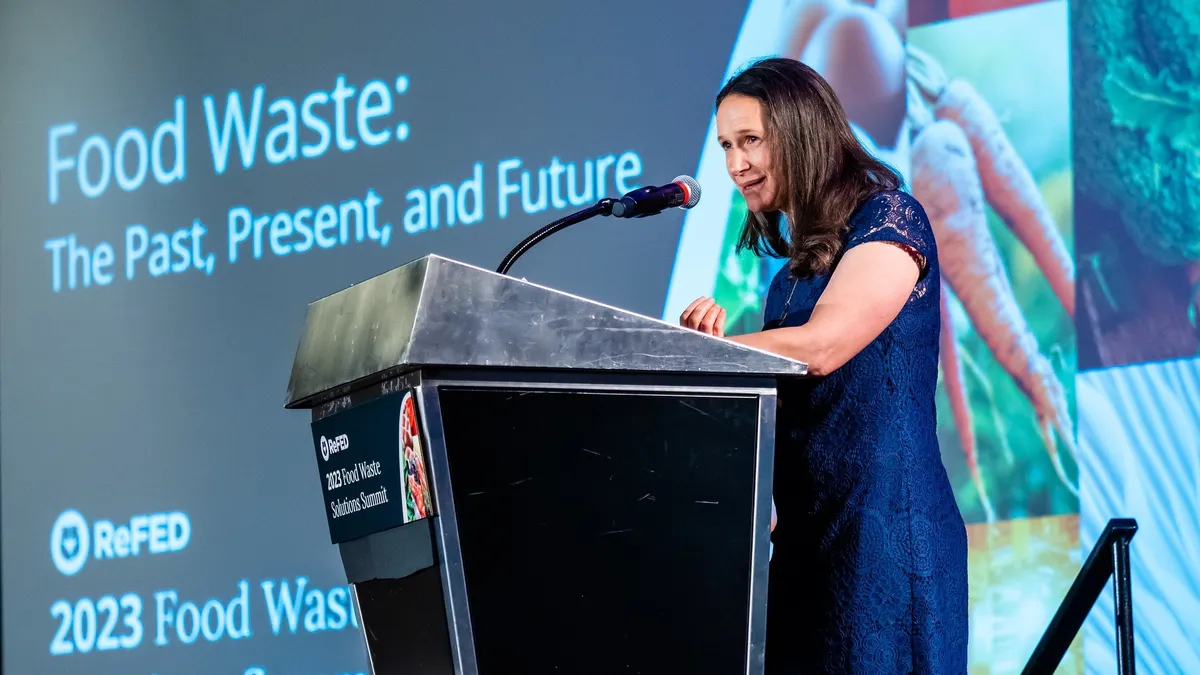Dive Brief:
- ReFED Executive Director Dana Gunders called for retailers to beginning scaling up food waste pilot programs, saying during a speech at the group’s Food Waste Summit in May that stakeholders weren’t making the progress needed to meet waste reduction goals.
- Gunders also said more stakeholders across the supply chain need to incorporate data regarding food waste to become more efficient, and she urged stronger action at the national level. The U.S. has made little progress toward achieving its goal of halving food waste per capita as outlined in its 2030 Food Loss and Waste Reduction Goal, per the most recent EPA data.
- "We're not moving the needle as much as we need to be moving it," Gunders said during the event in St. Louis. "I love the passion in this room ... It's like a growing army of people joining the movement, but I think we need to move past being a movement."
Dive Insight:
Gunders' comments came as both the U.S. and international community struggle to meet a United Nations goal of halving food waste and loss by 2030. The U.S. goal attempts to cut food waste to 164 pounds per person, compared with 328 pounds in 2016.
Gunders said achieving that goal would also require greater national coordination. Echoing a demand raised by the Zero Food Waste Coalition in April, Gunders said that the federal government should expand the role of the U.S. Department of Agriculture’s food loss and waste reduction liaison to a full office with greater authority. She also called on the Biden administration to coordinate with the CEOs of food companies to identify and remove barriers to cutting food waste and loss.
"Why is funding to the space a drop in the bucket compared to something like electric vehicles?" Gunders asked. "We need the level of work on this issue to be commensurate with the opportunity that it presents."
The summit came as ReFED continues to expand its efforts to track and guide food waste reduction efforts. In April, the nonprofit released new data finding that the U.S. may have reached peak food waste, with the total amount of surplus food declining by 0.6% since 2019 overall. That year, the EPA found food waste per capita reached 349 pounds.
ReFED’s capital tracker also logged a slowdown in the total value of deals in the private sector related to food waste and loss — from $1.9B in 2021 to $1.64B in 2022. The sector logged $774M in deals so far this year, per the tracker.
Gunders said there are opportunities to scale existing solutions, though, including via enhanced demand planning software. The nonprofit estimates that if retailers and other stakeholders incorporate such software to improve demand forecasting for perishable goods, they could drive $832 million of profit while diverting 265,000 tons of food waste annually. Gunders noted that a recent pilot of such software with two unnamed retailers in the Pacific Coast Food Waste Collective resulted in a 14.8% average reduction in food waste per store.
There have been positive developments in the food waste sector, including from a regulatory perspective, Gunders noted. In January, President Biden joined the leaders of Mexico and Canada in a non-binding agreement to tackle food waste reduction as part of the leaders’ shared North American commitments to reduce greenhouse gas emissions.
Gunders also said she was hopeful this year's reauthorization of the U.S. Department of Agriculture’s budget — through legislation known as the farm bill — could result in the adoption of bills that tackle food waste through EPA grants like the Zero Food Waste Act or COMPOST Act, which have been reintroduced this year. She also mentioned the Food Date Labeling Act, which would standardize “Best By” and “Use By” dates and has received bipartisan support.
"There's a real chance that all of this gets a little bit more attention and some of it hopefully gets included in the farm bill," Gunders said. "So far, food waste has really remained a bipartisan issue."










